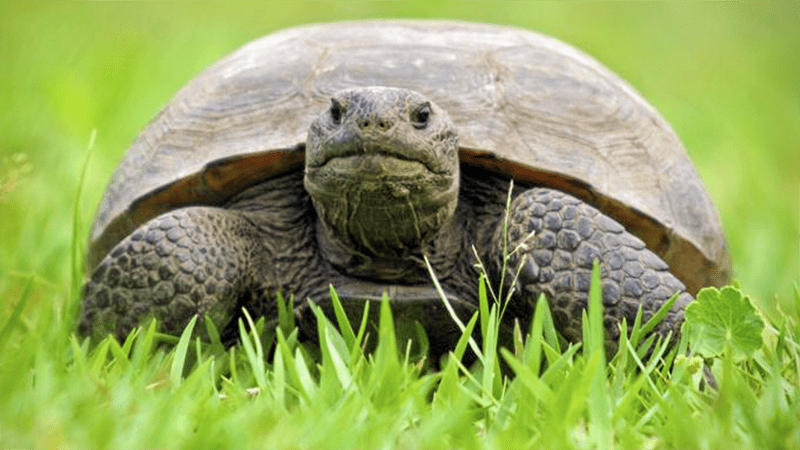
The U.S. Fish and Wildlife Service denied a request to list Florida gopher tortoises as endangered or threatened species.
{Craig ONeal / Wikimedia Commons}
By Jim Saunders
Concluding that the animals are “not in danger of extinction,” federal wildlife officials Tuesday rejected listing gopher tortoises in Florida as endangered or threatened species.
The U.S. Fish and Wildlife Service released a 113-page decision that said gopher tortoises would continue to be considered a threatened species in parts of southwest Alabama, Mississippi, and Louisiana under the Endangered Species Act.
But it said increased protections are not warranted for gopher tortoises in Florida, Georgia, South Carolina, and other parts of Alabama, despite issues such as development moving into the animals’ habitats.
“Although the threats to the species of habitat loss and fragmentation due to urbanization, climate change, sea level rise, and habitat management are expected to persist in the foreseeable future, and the effects of these threats on this long-lived species will continue at some level, some threats have been reduced and will continue to be reduced through implemented and ongoing conservation actions and regulatory mechanisms,” the agency’s decision said.
But the Center for Biological Diversity, which filed a lawsuit that helped spark a review of the animal’s status, sharply criticized the decision.
“Denying gopher tortoises the protection they need to survive is indefensible,” attorney Elise Bennett, Florida director for the Center for Biological Diversity, said in a prepared statement. “It ignores devastating urban sprawl that’s decimated the tortoise’s habitat and will continue to drive the species ever closer to extinction.”
Gopher tortoises have long spurred debates in Florida as development has spread and conservationists have pushed for habitat protections. Gopher tortoises are considered threatened by the state, which has a permitting process for capturing and relocating the animals.
The Legislature this year passed a measure that took steps to increase the sites where gopher tortoises can be moved. In part, the bill (SB 494) directed state agencies to consider using parts of certain public lands as gopher tortoise “recipient” sites. Also, it called for the Florida Fish and Wildlife Conservation Commission to “streamline and improve the review of applications for public and private gopher tortoise recipient sites.”
But groups such as the Center for Biological Diversity have long sought increased protections for the animals.
In the lawsuit filed last year in federal court in Washington, D.C., the Center for Biological Diversity accused the Fish and Wildlife Service of “dragging its feet” on listing gopher tortoises and other species as endangered or threatened. A settlement in April led to the review.
The review included scenarios up to 80 years in the future. While it said gopher tortoises are “likely to become endangered within the foreseeable future” in the region that includes southwest Alabama, Mississippi, and Louisiana, that was not the case in areas such as Florida.
“After evaluating threats to the species and assessing the cumulative effect of the threats … we conclude that the risk factors acting on the gopher tortoise and its habitat, either singly or in combination, are not of sufficient imminence, scope or magnitude to rise to the level to indicate that the species is in danger of extinction now (an endangered species), or likely to become endangered within the foreseeable future (a threatened species), throughout all of its range,” the decision said.
But the Center for Biological Diversity said in a news release that development and habitat loss for gopher tortoises “limits food availability and options for burrow sites, which exposes them to being crushed in their burrows during construction, run over by cars or senselessly attacked by people.”
“This denial is a blow to the gopher tortoise and all the people who care deeply about this humble creature’s future, but we won’t give up,” Bennett said. “We’ll review this decision closely and fight to get the tortoise the protections it needs to survive.”
Send Your News to Coral Springs #1 Award-Winning News Site Here. Don’t miss reading Margate Talk, Parkland Talk, and Tamarac Talk.
Author Profile
Related
 NewsFebruary 25, 2023Republican Senator Suggests Limiting Electric Vehicle Use During Emergencies Due to Lack of Charging Infrastructure
NewsFebruary 25, 2023Republican Senator Suggests Limiting Electric Vehicle Use During Emergencies Due to Lack of Charging Infrastructure NewsDecember 18, 2022Legislation Proposed By DeSantis Would Save Some Commuters $550 a Year in Tolls
NewsDecember 18, 2022Legislation Proposed By DeSantis Would Save Some Commuters $550 a Year in Tolls NewsDecember 8, 2022Higher Electric Bills Coming this January
NewsDecember 8, 2022Higher Electric Bills Coming this January NewsDecember 5, 2022Gas Prices Continue to Drop: Here is The Lowest in Coral Springs
NewsDecember 5, 2022Gas Prices Continue to Drop: Here is The Lowest in Coral Springs







